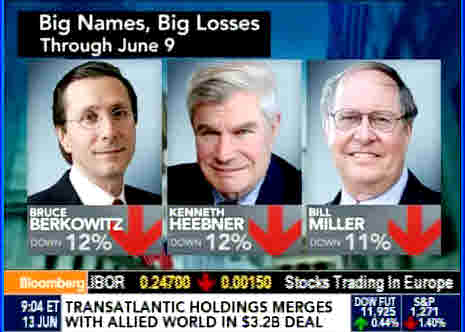Revisiting the Principle of Maximum Ruin
Posted: Mon Jun 13, 2011 9:17 am
Revisiting the Principle of Maximum Ruin:

Well known stock-pickers have had disastrous results so far
this year. Fund results:
Bruce Berkowitz, down 12%
Kenneth Heebner, down 12%
Bill Miller, down 11%
According to Bloomberg TV this morning, they all bet on an economic
recovery, and they all lost big.
Hey kids, what time is it?
It's time to re-post the following, that I've posted many times:
generational crash following the implosion of a credit bubble, the
markets act in an incredibly ingenious manner, to ruin the maximum
number of people to the maximum extent possible.
John

Well known stock-pickers have had disastrous results so far
this year. Fund results:
Bruce Berkowitz, down 12%
Kenneth Heebner, down 12%
Bill Miller, down 11%
According to Bloomberg TV this morning, they all bet on an economic
recovery, and they all lost big.
Hey kids, what time is it?
It's time to re-post the following, that I've posted many times:
This is what I call the Principle of Maximum Ruin. During aJohn Kenneth Galbraith in The Great Crash - 1929 wrote: > "A common feature of all these earlier troubles [previous panics]
> was that having happened they were over. The worst was
> reasonably recognizable as such. The singular feature of the
> great crash of 1929 was that the worst continued to worsen. What
> looked one day like the end proved on the next day to have been
> only the beginning. Nothing could have been more ingeniously
> designed to maximize the suffering, and also to insure that as few
> as possible escaped the common misfortune.
> The fortunate speculator who had funds to answer the first margin
> call presently got another and equally urgent one, and if he met
> that there would still be another. In the end all the money he
> had was extracted from him and lost. The man with the smart
> money, who was safely out of the market when the first crash
> came, naturally went back in to pick up bargains. ... The
> bargains then suffered a ruinous fall. Even the man who waited
> out all of October and all of November, who saw the volume of
> trading return to normal and saw Wall Street become as placid as
> a produce market, and who then bought common stocks would see
> their value drop to a third or fourth of the purchase price in the
> next twenty-four months. ... The ruthlessness of [the stock
> market was] remarkable." (p. 108)"
generational crash following the implosion of a credit bubble, the
markets act in an incredibly ingenious manner, to ruin the maximum
number of people to the maximum extent possible.
John